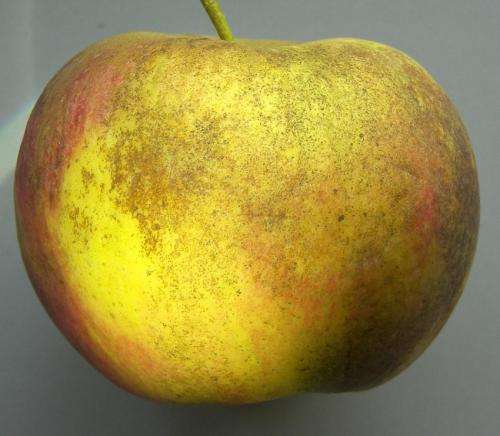Study reveals causes of apple skin spot

For fruit crops such as apples, compromised skin appearance usually results in reduced market value. Identifying causes of fruit disorders and diseases can help producers modify growing strategies and increase profits. Researchers in Germany recently released a study of "skin spot", a disorder found in 'Elstar' (and occasionally in 'Golden Delicious') apples after CA storage that is characterized by patches of small brownish dots that usually appear on the apples' skin after the fruit is moved from storage.
"Previous report have suggested that apples are particularly susceptible to skin spot if they are poorly colored, from dense canopies, grown in wet years, or harvested late," noted Moritz Knoche, corresponding author the study published in HortScience. Knoche explained that skin spot comprises patches of small, brownish spots that are caused by the death of individual epidermal and hypodermal cells underlying microcracks in the fruit cuticle. A research team investigated the relationship between surface water on fruit, the formation of microcracks in the fruit cuticle, and the severity of skin spot in 'Elstar' apples grown under rain shelters. During the study, fruit surface wetness was maintained by overhead sprinklers installed above apple trees grown under a plastic rain shelter (deployed between 5 and 134 days after full bloom). The experiments featured four different wetness periods.
Analyses showed that increasing fruit surface wetness by overhead sprinkling increased both the severity of skin spot and the severity of cuticular microcracking. "Most skin spots and microcracks were already present by harvest time and before storage," the researchers noted. "However, the severities of both increased significantly during storage. Surface wetness between 14 and 44 days after first bloom had no effect on the severity of skin spot compared with dry, control fruit but markedly increased the surface area percentage of the skin that was russeted." The scientists said there was essentially no skin spot or russeting when the apple surfaces were kept dry.
The researchers also studied the severity of skin spot under standard orchard conditions over a 9-year period and discovered that the disorder was positively correlated with the number of rainy days during the period. "In relation to the severity of skin spot, surface wetness is better described by the number of rainy days than by the cumulative rainfall amount," they explained. "A commercially critical skin spot score of 2 is predicted if there are more than 44 rainy days between August 1 and harvest for control fruit, and if there are more than 34 rainy days for 1-methylcyclopropene-treated fruit," Knoche said.
The results demonstrated that surface wetness results in the formation of microcracks in the cuticle, which in turn is a prerequisite for the formation of skin spot. Skin spot in 'Elstar' apple arises as a result of microcracking, and this is a result of late-season surface wetness.
Knoche added that russeting and skin spot may both be viewed as a wound reaction of the fruit. "The initial event, the crack in the cuticle, is identical (both water induced); however, the subsequent events differ. In russeting, a periderm is formed in the young and developing fruit as a protective layer. In skin spot, no periderm is formed, but lignin incrustration of the cell walls seals the portion of the tissue underlying the crack off. The "damage" (crack) is contained. Why apple fruit does not respond with russeting later in development nobody knows."
More information: The complete study and abstract are available on the ASHS HortScience electronic journal web site: hortsci.ashspublications.org/c … /49/10/1324.abstract
Journal information: HortScience
Provided by American Society for Horticultural Science



















